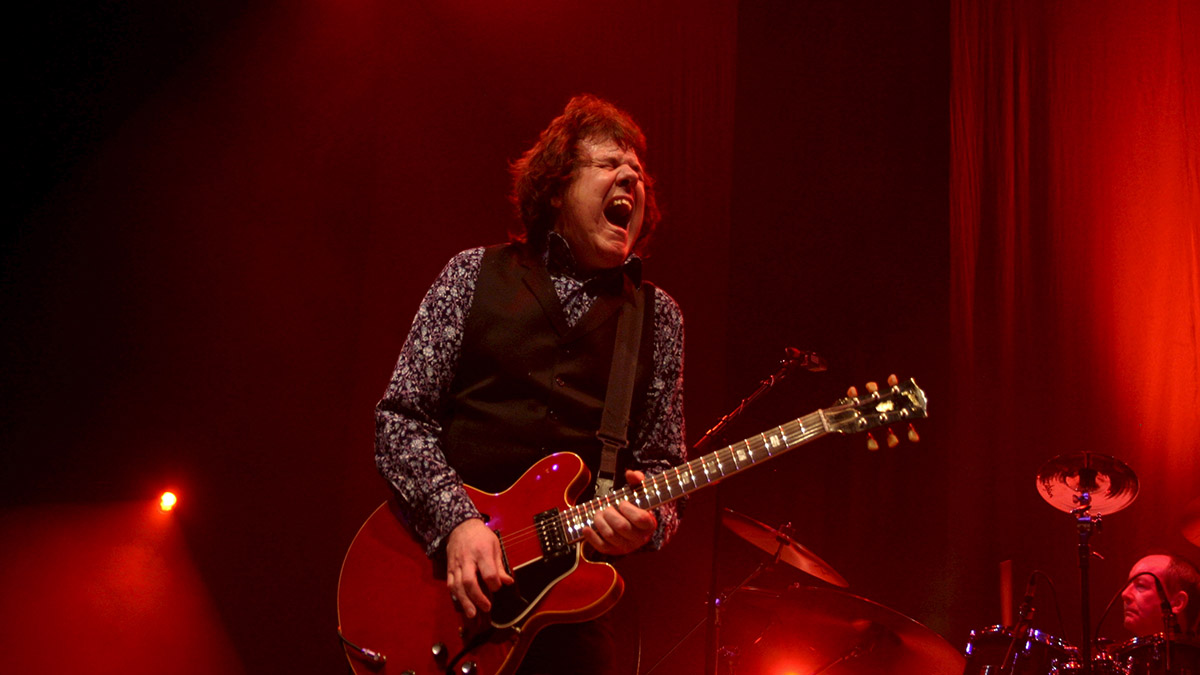Watch Gary Moore dispense wisdom, play jazz and shred blues on a Gibson Explorer in these classic interviews
Moore talks phrasing, sustain, the blues-rock dynamics of The Power Of The Blues riff and more in these ol' videos from the archives
The late, great Gary Moore was born on this day in 1952 and the occasion of his birthday has us trawling through the archives, whereupon a peach of a video came into focus. Sadly, very soft focus – time has not been kind on the video definition of this 2004 interview with Moore.
Nonetheless, this conversation, conducted over electric guitars – a Gibson Les Paul and Explorer respectively – just as The Power Of The Blues was fresh in record shops, remains an invaluable insight into a bona-fide legend’s craft. It’s also a vulgar display of casual genius, of ad hoc virtuosity to underline a point, whether it be the sustain of a Les Paul or the supreme playability of the underrated Explorer.
It is difficult to overstate how good a player Moore was, all the more impressive when you consider how he was conversant in all kinds of styles. Sure, he was rooted in the blues, but was soon to entertain a harder edge and take into rock, and to metal guitar. He could also play jazz, fusion, whatever you needed just so long it was on six-strings and the guitar was in tune.
Here he deconstructs the title track from The Power Of The Blues, demoing the riff, and how he takes that 12-bar I-IV-V power-blues progression and then switches up the tempo and turns it into a shuffle for “a bit of shock value in the middle”.
Moore also has some advice for the prolix guitar player, and we have surely all been one, coming down with acute case of fretboard diarrhoea and using too many notes in our solos.

Take a phrase, says Moore, and work on it, playing around with all the different permutations, accenting the first, second, or maybe the last notes, working on the dynamics – these are all ways of workshopping your phrasing and learning how to make more out of something simple and familiar. Those phrasing skills can then be upscaled and deployed so that you don’t lose that sense of self-expression when playing faster solos
Here Moore plays a lick three different ways. It would all look the same on the sheet music but it sounds different in each instance.
Get the MusicRadar Newsletter
Want all the hottest music and gear news, reviews, deals, features and more, direct to your inbox? Sign up here.
“It’s the nuance,” says Moore. “Even two notes. It’s just how you interpret it, and that’s really what makes the difference. If you play everything really, really straight, it sounds so cold and boring. It’s putting what you feel into it, and bending a note the way you feel it should be bent. Otherwise it doesn’t have any character. It doesn’t really say anything.”
Time to switch to the Explorer, and a demonstration of 1) Just how hard Moore can hit those strings at lightning speed, and 2) Just how versatile an Explorer can be. Why not use a bold shape for electric blues? As Moore notes, it didn’t do Albert King any harm.
The video might look VHS but Moore’s wisdom, and the unalloyed magic of him cutting loose on guitar, comes over as clear as a bell. Check it out at the top.
And for a two for two, how about this video interview above, in which Moore, throws some jazz shapes about the ‘board on a Les Paul, and then demonstrates a certain out-of-phase sound on another Les Paul, and then sets off a fire alarm when shredding blues on an ES-335.
When you play blues guitar with such an intensity it starts to play havoc with the infrastructure, well, that’s when you know you’ve got something.
Jonathan Horsley has been writing about guitars and guitar culture since 2005, playing them since 1990, and regularly contributes to MusicRadar, Total Guitar and Guitar World. He uses Jazz III nylon picks, 10s during the week, 9s at the weekend, and shamefully still struggles with rhythm figure one of Van Halen’s Panama.










